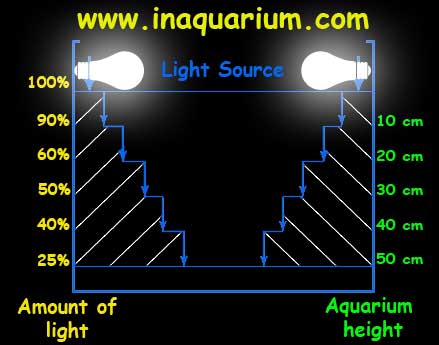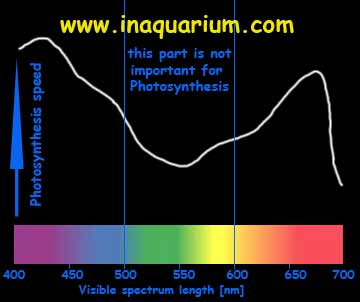Light plays an important role in the oxygen production by plants and is required by fish and other aquatic animals to function correctly. Only in the presence of light plants synthesize organic compounds from simple inorganic substances. Light regulates the basic fish life processes. Additional feature which correct lighting gives is improvement of visual presentation of the aquarium and it's inhabitants.
The amount of light that gets inside the aquarium depends on many factors: the angle of the light which hits the tank, water clarity (which influences the amount of absorbed and scattered rays of light in water), the number of obstacles encountered. Plants need mostly blue and red parts of the light.
Light intensity changes (decreases) with the depth (height) of the tank changes light intensity. So keep in mind that the higher the aquarium is the stronger lighting you have to install.

Natural light source used in addition to artificial lighting. If the sun was the only source of light then in the winter months there would be a shortage of light and plants vegetation would be slowed down. Sun light is not recommended for use. You should never place an aquarium on the windowsill as it will accelerate the algae growth and high temperature changes between night and day.
This light source becomes less and less popular. Standard light bulbs become very hot (which may lead to water temperature increase) and their efficiency is not that good (only 5% of the energy is converted into light. The rest of the energy is converted into heat). Standard light bulbs emit a lot of red light.
Now widely used as an artificial source of the light. This source of light is very economical (long life, cheap to buy, about 15% of the energy is converted into light). Fluorescent light bulbs emit more blue light. They are also available in different colors. Fluorescent lighting
Now widely used as an artificial source of the light. This source of light is very economical (long life, cheap to buy, about 15% of the energy is converted into light). Fluorescent light bulbs emit more blue light. They are also available in different colors. Fluorescent lighting intensity reduces with time. The fluorescent lights life time is around one year.
Characterized by high performance and low operating costs (as opposed to fluorescent lamps this do not lose its light intensity along the time). Recommended for use in the aquariums with height greater than 60 cm. Designed for aquarium with no cover (they should not be mounted directly above the water). You have to remember that if you use very strong light in your aquarium you need to supply carbon dioxide for plants to grow better.
Are more appropriate than the mercury lamps due to the better light color. Also suitable for large tanks. If used for large tanks you may need additional light source (spot light source would be useful). This lamps have short live time and become quite hot. You have to remember that if you use very strong light in your aquarium you need to supply carbon dioxide for plants to grow better.
is the most expensive solution (purchase cost) but also the cheapest in terms of cost to run. Mainly used to light the aquarium at night (low light output). This light is not suitable for plants.
When it comes to plant grow the best light waves for photosynthesis are 400-450nm and 650-700nm. Not to importent are light waves around 550nm. The following graph shows the dependence of photosynthesis speed throughout the light spectrum:

On the market there are many fluorescent lamps specially designed for plant growing such as: Philips Aquarelle, Osram, Sylvania Grolux, Hagen Aqua Glo, but they are not cheap. Let us examine whether it is worth investing in this type of light. Let's start from the light parameters that are the most important for aquarium.
Fluorescent lighting is characterized by the following parameters:

Parameter RA, brightness and color temperature are not important for the plants saying that light should have low color temperature is only a myth. The second myth is that the special aquarium lamps are better than standard fluorescent lamps. Lamps specially designed for aquarium, made by famous companies are nicely packaged and have a fantastic names but they are made using the same technology and their features are very similar to conventional fluorescent lamps. However a significant difference in price will be noticeable. It is true that fluorescent lamps are better and worse, but I want to tell you that there is no lamps not to be suitable for the aquarium. All light sources have rich spectrum and if the plants grow poorly in the aquarium. If your plants are not growing correctly look into the characteristics of water, nutrient access (provided by fish or artificial fertilizer like carbon dioxide) and lighting power in the aquarium.
If you're wondering what color of the light give light sources with different light temperature then take a look at spectral diagram below.

Below, there are aquariums which have different light sources installed - various popular brands with different light temperatures.









As you can see, the color corresponds to the spectral diagram. If anyone would like to have a nice effect in the aquarium then can easily go to the store and buy a suitable fluorescent tube with desired color temperature. You can mix two different fluorescent tubes and get a mix of colors.
NOTE. Some lamps can not be used alone because they can increase the algae growth so mixing two fluorescent lamps which have different color temperatures is a good solution.
There are T5 and T8 fluorescent tubed available on the market. Will try to explain the differences between those two types:
It tells us that the purchase of T5 is a good choice in terms of performance and the benefits it gives you like small size, high efficiency, long service life. However, the difference in price compared to T8 is significant. Therefore before the purchase carefully consider which one to choose. When choosing to remember that T8 light parameters are not really different from T5 tubes in terms of the spectrum of light and the rate of RA. They have a slightly lower viability and efficiency but also will bring colors of the fish in the aquarium. Both tubes T5 and T8 will keep the growth of plants.
These numbers contain encoded RA factor and color temperature. Lets look at some examples: Philips 840 tells us that RA factor is greater than 80 and less than 90 (figure 8) and the color temperature is 4000K (number 40). Another example - 965 says that RA is greater than 90 which is very good and the bulbs are more expensive than eights, a color temperature of 6500K. Sometimes there are minor differences, such as NARVA Biovital 955, which has a color temperature of 5800K rather than the 5500K which is suggested by the number 55. So, in order to accurately assess the color temperature and RA factor refer to the documentation of the fluorescent tube or go to the manufacturer's website.
The price, size, power, and spectra of individual fluorescent tubes are presented below to give you a picture of what manufacturers currently have to offer. I hope that will help you to select desired tube. This ranking is quite big so I decided to put them on separate page. Link below.
You'll find there fluorescent tubes from many manufacturers with all color temperatures. Prices are taken from online stores (average prices). The aquarium shops can be a bit more expensive. I do not want to show exactly how much they cost. The main reason is to provide the difference in price between the different tubes, so that you can determine which is the most economic.
I wish you a nice reading and analysis :).
There are different methods to estimate the required light output. The old Ringwald's rule says that 1 dm2 area of the tank bottom should have 0.75 W fluorescent lighting or 2W of standard light bulbs power (this is accurate for 30-litre tank). Another rule says that there should be 0.5W of light power per litre of water. It really all depends on the depth of the tank and on what we will keep in it. For planted aquariums lighting should be about 0.6 W / litre of water. It is important to maintain the correct balance between the power of light and the amount of nutrients available to plants. We will waste light power if we will not supply enough nutrients for plants.
The more lumens light has then the human eye thinks that the light is brighter. However, the human eye can be fooled and not always brighter light means that the number of photons emitted by it is greater. To determine the amount of light required we need to taken into account another parameter - the number of watts light have. To reduce light losses you can also use reflectors. Reflectors are made of highly polished (like a mirror) aluminum casings for fluorescent lamps which direct all light downward, maintaining the lowest possible light losses. This reduces requirement of the light output of up to 30%. They are not expensive (from $5 to $15). Result can be seen straight away after installing it in the aquarium. You should also keep the surface of water in motion otherwise it will act like a mirror reflecting the light and causing losses. To do that use filters, aerators, etc.
Note. If you have strong light in the aquarium you should provide carbon dioxide and nutrients in larger quantities for plants. However be careful not to damage the biological balance. When you excess amount of nutrients and plants will not be able to use them all algae will start to grow.
To have light in aquarium as close as possible to the natural lighting it is recommended to mix light tubes (eg, red and blue fluorescent lamps, fluorescent lamps of warm and cool light, etc). It is important that during the day tank was lighted for 12-14 hours. Light sources should be mounted in the aquarium cover (purchased at a pet store or made by yourself). You need to insulate the interior with aluminum foil, by painting with white paint or mount mirrors inside it to reduce light losses. Fluorescent tube length should be shorter than the aquarium as you will need space for elements which will attach the light to the cover. Stronger light should be at the front of the tank (plants will buckle in the direction of the light). You should replace tubes one by one with month interval between each change